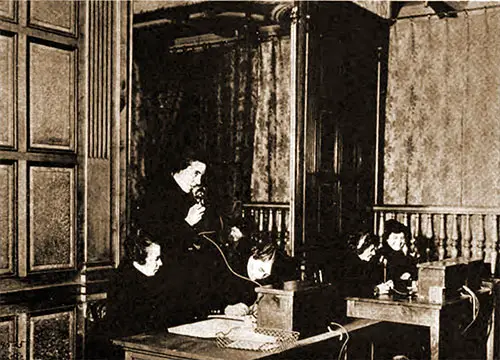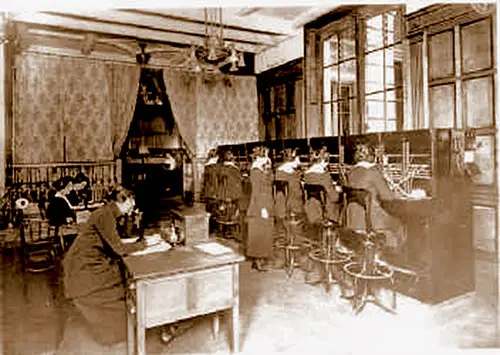The Telephone Girls of the Peace Conference - 1921

Signal Corps Telephone Girls Handle the Telephone Switchboard Room at Hotel De Crillon, Headquarters for American Delegation It Peace Conference, Paris. The Telephone Review, April 1919. GGA Image ID # 198796232e
And as to the operation of President Wilson's switchboard at the Paris "White House," Miss Beatrice Francfort has this to say:
When I was chosen to take charge of the President's switchboard at the Murat Mansion, I felt that I had reached the pinnacle of accomplishment. We were set up in our office there and began a hurried preparation for the President.
Naturally, we wanted everything to be perfect. The three of us, Miss Martha Carrel, Miss Lillie Noble, and I got together and compiled an information book, placing in it the names and numbers of ambassadors, officials, prominent places, and anything and everything that might possibly be needed.
Even at that, we sometimes struck a snag, and in such a case, appealed to the American or British embassy and received excellent help from them.
In calling, we used to say, "President's house," and found that it held the magic of "Open Sesame" —to all but the French.
They refused to be hurried by anyone or anything. Life is too short and must be enjoyed restfully. Sometimes, when a message was being sent over their wires, and they found that there was likely to be some delay, they would calmly advise that a courier be sent!
That the telephone girls were popular, not only with the Commander-in-Chief of the A. E. F. but with the entire A. E. F. as well is so well known that it needs no reiteration.

Merle Egan Anderson, Sitting at the Supervisor's Desk at the Paris Peace Conference in the Hotel Crillon. She Led the Fight from 1930 - 1978 for Recognition of the Hello Girls' Veteran-Status. GGA Image ID # 197803e2d0
On more than one occasion, Pershing spoke very highly of the excellent way these girls had discharged their duties and the fine esprit de corps and willingness to serve that characterized France's operating units. But that the girls were equally popular with President Wilson and the Peace Missions is not so widely known because of the quiet way in which the latter conducted their activities.
On one occasion, when the President and Mrs. Wilson gave a tea party to their official family members, he insisted that the three girls assigned to the Murat Mansion switchboard should assist the hostess in pouring tea and receiving the other guests.
The special operator between the President's house and the Elysees Palace was Miss Mary C. O'Rourke, who assured the author in Paris, on one occasion, that she knew she stood in well with the Administration because Mrs. Wilson always prefaced her wants with "Nice little girl, will you get me, etc."
Nothing could be more characteristic of the American telephone habit than the particular way in which all those connected with the American Peace Delegation were made accessible to the reach of the telephone—sometimes, indeed, at the expense of privacy—a sacrifice not deemed too significant for the readiness and get-at-able-ness provided by the telephone service.
Because of this, relates J. G. Patterson, of the New England Telephone and Telegraph Company, a certain Motor Dispatch Sergeant has a vivid recollection of a telephone conversation with the United States President he does not care to have made part of his service record.
It seems that during the Peace Conference, the sergeant was at one time in charge of assigning official motor cars to meet the various demands more efficiently. The sergeant's duty was to call up the several garages and stands where the vehicles were located and arrange their routes.
Following this custom, one morning, he telephoned to the Paris White House to get a line on the cars that might be there. Instead of the clerk who usually answered the telephone, the President, who happened to be standing nearby, picked up the instrument.
"The President speaking," he answered, following the best telephone usage.
The sergeant, however, knew when he was being "kidded."
"Aw—go on," he challenged, "how do you get that way?
You allez out and tell that chauffeur I want to talk to him."
The reply came back in the most dignified tones.
"But this is the President."
"The H--- it is! Do you mean it? I mean . . . excuse me, Sir . . . aw . . ."
And as the situation fully dawned upon the poor sergeant, he abandoned the line in haste and did not breathe freely again until he was back in the U. S. A., with his discharge buttoned securely inside his coat.
The quality of telephone service furnished the American Peace Delegation (and incidentally, the members of the other Peace Delegations who needed to use the American telephone service) is still spoken of with admiration.
Completed, the new central office represented a telephonic entree to the broadest stretch of European distance ever encompassed by wire on the other side of the Atlantic. It tied into a single system the nine Signal Corps offices in Paris, the other Allied headquarters, and all French commercial exchanges in the French capital, to say nothing of the constant expansion in telephone and telegraph range that was taking place during this period, while the American Third Army was moving forward into Luxemburg and Germany.
As a press correspondent put it at the time:
In Paris, the French Government granted the courtesy of the establishment of a parallel American telephone system. As a result, American linemen dived into the sewers and carried their strands of copper between American offices miles apart.
American electricians set up switchboards and all the delicate machinery of the telephone exchange in eight different bureaus.
American telephone girls came in from the front and from the big bases at Tours and Bordeaux to clap little listening cups over their ears and jiggle the talking spark.
They even took possession of the famous Crillon bar, a one-time gathering place for all the notables of the American colony and the Englishman loafing in Paris with guineas to spend.
In just five days, this home of the American cocktail and the British "B. and S." was purged of the rum demons and converted into an up-to-the-minute telephone exchange with eight "boards" and two chief operators.
Colonel Carty took the writer down there this afternoon to show me how thoroughly the old gods of the place had been routed.
There on their high stools before the maze of plugs sat eight American girls—so good to look at in their velvety cleanness and freedom from the heavy cosmetics that mark the girl of the boulevards.
Miss Clara Summers, who used to be in the Broad Street Exchange in New York City, was sitting at the chief operator's desk. Everything was running like an oiled spindle, not a voice raised, not an instant of confusion as the flying fingers threaded among the green and red bound wires.
Occasionally one of the operators put a question in pure French —for they all speak it—and now and then, a low laugh from one of the girls marked the efforts of an unseen and gallant American to pay homage to an authentic American voice.
While I was in the room, somebody at the "White House," where the President was living during his stay in Paris, wanted a connection with London; a call came in from Bordeaux down next to the Spanish border; an army officer at Treves, Germany, wanted to speak with his superior in the office at No. 1 Rue Tilsit.
And every connection was made swiftly, indeed, by those soldiers of the whispering wire.
The President's telephonic arm's vast reach referred to in this press dispatch was not carried out without difficulty. Indeed, the rapid forward movement of the occupying armies presented unusual challenges concerning the extension and establishment of wire lines of communication.
A. Lincoln Lavine, "Chapter L: After the Armistice," in Circuits of Victory, New York: Country Life Press/Doubleday, Page & Company, 1921, pp. 610-613.
